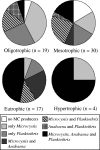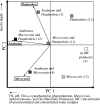Detection of microcystin-producing cyanobacteria in Finnish lakes with genus-specific microcystin synthetase gene E (mcyE) PCR and associations with environmental factors
- PMID: 16957235
- PMCID: PMC1563646
- DOI: 10.1128/AEM.01058-06
Detection of microcystin-producing cyanobacteria in Finnish lakes with genus-specific microcystin synthetase gene E (mcyE) PCR and associations with environmental factors
Abstract
We studied the frequency and composition of potential microcystin (MC) producers in 70 Finnish lakes with general and genus-specific microcystin synthetase gene E (mcyE) PCR. Potential MC-producing Microcystis, Planktothrixand Anabaena spp. existed in 70%, 63%, and 37% of the lake samples, respectively. Approximately two-thirds of the lake samples contained one or two potential MC producers, while all three genera existed in 24% of the samples. In oligotrophic lakes, the occurrence of only one MC producer was most common. The combination of Microcystis and Planktothrix was slightly more prevalent than others in mesotrophic lakes, and the cooccurrence of all three MC producers was most widespread in both eutrophic and hypertrophic lakes. The proportion of the three-producer lakes increased with the trophic status of the lakes. In correlation analysis, the presence of multiple MC-producing genera was associated with higher cyanobacterial and phytoplankton biomass, pH, chlorophyll a, total nitrogen, and MC concentrations. Total nitrogen, pH, and the surface area of the lake predicted the occurrence probability of mcyE genes, whereas total phosphorus alone accounted for MC concentrations in the samples by logistic and linear regression analyses. In conclusion, the results suggested that eutrophication increased the cooccurrence of potentially MC-producing cyanobacterial genera, raising the risk of toxic-bloom formation.
Figures




References
-
- Carmichael, W. W. 1994. The toxins of cyanobacteria. Sci. Am. 270:78-86. - PubMed
-
- Dittmann, E., and T. Börner. 2005. Genetic contributions to the risk assessment of microcystin in the environment. Toxicol. Appl. Pharmacol. 203:192-200. - PubMed
-
- Dittmann, E., B. A. Neilan, M. Erhard, H. von Döhren, and T. Börner. 1997. Insertional mutagenesis of a peptide synthetase gene that is responsible for microcystin production in the cyanobacterium Microcystis aeruginosa PCC 7806. Mol. Microbiol. 26:779-787. - PubMed
Publication types
MeSH terms
Substances
LinkOut - more resources
Full Text Sources
Miscellaneous

